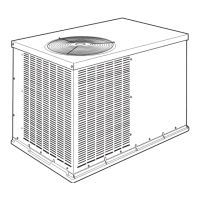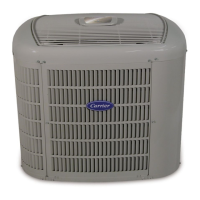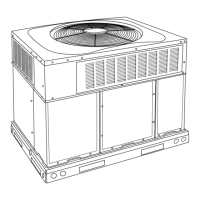25
513 01 3103 00
23cracking) to occur in one year or more. When performing any
service that may risk exposure of compressor oil to the roof, take
appropriate precautions to protect roofing. Procedures which risk
oil leakage include, but are not limited to, compressor
replacement, repairing refrigerant leaks, replacing refrigerant
components such as filter drier, pressure switch, metering device,
coil, accumulator, or reversing valve.
Synthetic Roof Precautionary Procedure
1. Cover extended roof working area with an impermeable
polyethylene (plastic) drip cloth or tarp. Cover an
approximate 10 x 10 ft (3 x 3 m) area.
2. Cover area in front of the unit service panel with a terry
cloth shop towel to absorb lubricant spills, prevent run--offs,
and protect drop cloth from tears caused by tools or
components.
3. Place terry cloth shop towel inside unit immediately under
component(s) to be serviced and prevent lubricant run--offs
through the louvered openings in the unit base.
4. Perform required service.
5. Remove and dispose of any oil contaminated material per
local codes.
LIQUID LINE FILTER
DRIER
The filter drier is s pecifically designed to operate with R --410A.
Use only factory--authorized components. Filter drier must be
replaced whenever the refrigerant system is opened. When
removing a filter drier, use a tubing cutter to cut the drier from the
system. Do not unsweat a filter drier from the system. Heat from
unsweating will release moisture and contaminants from drier into
system.
R--410A REFRIGERANT
CHARGING
Refer to unit information plate and charging chart. Some R --410A
refrigerant cylinders contain a dip tube to allow liquid refrigerant to
flow from cylinder in upright position. For cylinders equipped with
a dip tube, charge R--410A units with cylinder in upright position
and a commercial metering device in manifold hose. Charge
refrigerant into suction--line.
TROUBLESHOOTING
Refer to the Troubleshooting Chart (Table 9 for troubleshooting
information.
START--UP CHECKLIST
Use the Start--Up Checklist at the back of this manual.
AIR CONDITIONER WITH R--410A QUICK REFERENCE GUIDE
R--410A refrigerant operates at 50--70 percent higher pressures than R --22. Be sure that servicing equipment and replacement
components are designed to operate with R--410A. R--410A refrigerant cylinders are rose colored.
S R --410A refrigerant cylinders manufactured prior to March 1, 1999, have a dip tube that allows liquid to flow out of cylinder in upright
position. Cylinders manufactured March 1, 1999 and later DO NOT have a dip tube and MUST be positioned upside down to allow liquid
to flow.
S Recovery cylinder service pressure rating must be 400 psig. DOT 4BA400 or DOT BW400.
S R--410A systems should be charged with liquid refrigerant. Use a commercial type metering device in the manifold hose.
S Manifold sets should be minimum 700 psig high--side and 180 psig low--side with 550 psig low --side retard.
S Use hoses with minimum 700 psig service pressure rating.
S Leak detectors should be designed to detect HFC refrigerant.
S R --410A, as with other HFCs, is only compatible with POE oils.
S Vacuum pumps will not remove moisture from oil.
S Only use factory specified liquid--line filter driers with rated working pressures no less than 600 psig.
S Do not install a suction--line filter drier in liquid line.
S POE oils absorb moisture rapidly. Do not expose oil to atmosphere.
S POE oils may cause damage to certain plastics and roofing materials.
S Wrap all filter driers and service valves with wet cloth when brazing.
S A R --410A liquid --line filter drier is required on every unit.
S Do not use an R--22 TXV.
S Never open system to atmosphere while it is under a vacuum.
S When system must be opened for service, break vacuum with dry nitrogen and replace filter driers.
S Always replace filter drier after opening system for service.
S Do not vent R--410A into the atmosphere.
S Observe all warnings, cautions, and bold text.
S Do not leave R --410A suction line driers in place for more than 72 hrs.

